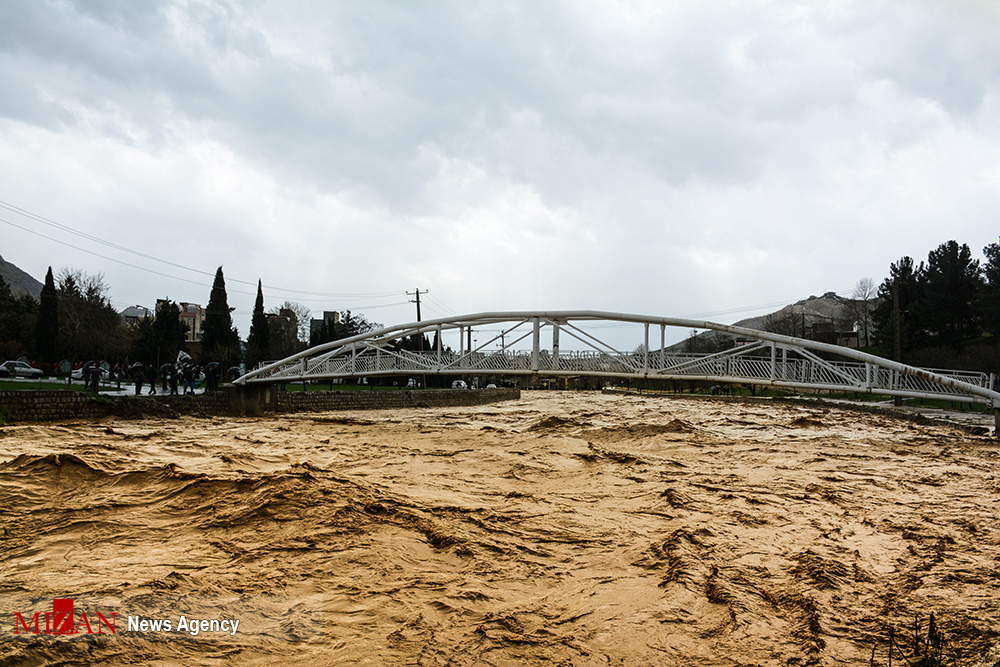Iran
expands flood warnings, tens of thousands evacuate after record
floods kill at least 70 people – “Iran is under water”
11 April
2019 shows trees partially submerged by water from floods in Ahvaz,
the capital of Iran’s southwestern province of Khuzestan –
Authorities ordered tens of thousands of residents of the
southwestern Iranian city of Ahvaz to evacuate immediately on 10
April 2019 as floodwaters entered the capital of oil-rich Khuzestan
province, state television reported. Photo:
Atta Kenare / AFP / Getty Images
Atta Kenare / AFP / Getty Images
13 April, 2019
By
Golnar Motevalli
=
=
(Bloomberg)
– Authorities in Iran expanded flood warnings to five additional
provinces Saturday as rescue efforts continue across the western
flank of the country already drenched by heavy rain.
Residents
from the northeast to the south, including islands in the Persian
Gulf, have been told to brace for flooding, thunderstorms and heavy
showers in the next two days, the semi-official Fars news reported,
quoting Ahed Vazife, director of meteorological forecasts and
warnings at the Meteorological Organization of Iran.
Severe
floods since 19 March 2019 have so far killed 70 people and forced
the evacuation of tens of thousands of others from scores of villages
across swathes of Iran’s northwestern and central region.
Khorasan
Razavi, Khorasan Shomali and Khorasan Junoubi in Iran’s northeast
and Sistan-Baluchistan, Bushehr and Hormuzgan in the south, including
the island of Qeshm, will be affected by a weather front starting as
soon as Saturday night and continuing into Sunday, Vazife is quoted
as saying.
Khorasan
Razavi, home to Iran’s second-largest city Mashhad, expects an
“unprecedented” level of rainfall of above 50 millimeters (2
inches) in some areas, Vazife said. [more]

23 March 2019, shows flooded streets in the northern Iranian village of Agh Ghaleh. Photo: Ali Dehghan / AFP / Getty Images
Record floods in Iran kill 62, cause more than $1 billion in damage
By
Dr. Jeff Masters
3 April 2019
3 April 2019
(Weather
Underground) – Weeks of torrential rains in Iran have caused record
flooding that have killed at least 62 people and caused $1.1 billion
in agricultural damage. Unofficial estimates have put the total
economic cost at $3.6 billion. According to EM-DAT, this would rank
as the second most expensive flood in Iranian history, behind the
$5.4 billion damage (2019 dollars) wrought by the floods of April –
June 1992. The death toll of the 2019 floods rank as the 18th
deadliest flood in Iranian history.
According
to a news
release put
out by the International Red Cross/Red Crescent (IFRC) on the crisis
on Wednesday, the floods started in mid-March in Golestan Province in
northeast Iran and have since spread to 23 of the country’s 31
provinces. Golestan received 70% of its annual rainfall in just one
day in mid-March. The floods have closed 2199 roads, damaged 84
bridges, and brought two dams near their maximum level, forcing
downstream evacuations. [more]

Following heavy rains in Lorestan province, devasting floods hit different parts of Lorestan, causing considerable damages in different cities of this province and overflowing of the Khorram Rood river. Photo: Mizan News Agency
“Iran is under water” – IFRC
announces support as flood
crisis worsens
Beirut/Geneva,
3 April 2019 (IFRC) – As the flooding emergency in Iran worsens,
the world’s largest humanitarian network has released just under
500,000 Swiss francs to bolster local Red Crescent relief efforts.
The
funds released from IFRC’s Disaster Relief Emergency Fund (DREF)
will be used to provide 3,000 families that have lost homes and
livelihoods with unconditional cash grants.
Sayed
Hashem, IFRC’s Regional Director for the Middle East and North
Africa, said:
“Iran
is under water. This is an unprecedented crisis that has now touched
at least 23 of Iran’s 31 provinces. While the precise impact is
still to be seen, it is already very clear that the floods have
caused extensive damage and suffering in villages, cities and rural
areas.”
The
Iranian Red Crescent is at the forefront of humanitarian response
efforts. According to figures provided by the Red Crescent, more than
11,000 of their relief workers have reached more than 192,000 people
across the country with life-saving care and support.
“The
Red Crescent response is massive, and it is growing every day. Red
Crescent volunteers and staff have evacuated hundreds of people to
safety, and have distributed food and items such as tents, blankets
and health kits to tens of thousands of people,” said IFRC’s
Hashem.
“But
the scale of this crisis means that more help is needed. So, in
addition to the funds we are providing, we are also working with our
Red Crescent colleagues in Iran to see how we can expand our
support.”
The
floods started in mid-March in Golestan Province in north-east Iran
and have now spread to at least 23 of the country’s 31 provinces.
They are the result of unprecedented rain fall. For example, Golestan
received 70 per cent of its annual rainfall in just one day in
mid-March. Further heavy rain is expected over the coming days which
will likely worsen the situation even further.
Contact
-
In Beirut: Rana Sidani Cassou, + 961 71 802 779, rana.cassou@ifrc.org
-
In Geneva: Matthew Cochrane, +41 79 251 80 39, matthew.cochrane@ifrc.org“




No comments:
Post a Comment
Note: only a member of this blog may post a comment.